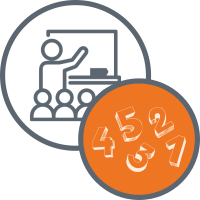CDE will be closed on Monday, Jan. 20 for the Martin Luther King, Jr. holiday.
You are here
Equity-Based Mathematics Teaching Practice 4: Challenging Spaces of Marginality
Instructional Support Menu
Challenging Spaces of Marginality
In the book The Impact of Identity in K-8 Mathematics (2013), the authors use two examples to highlight what they think it means to challenge spaces of marginality. In the first example, students make the accusation that Mexican students are disciplined unfairly at their school, and the teacher guides them to explore this claim mathematically. Students’ lived experiences with racism and discrimination are typically marginalized in mathematics instruction, and the teacher challenges that space in this example by empowering students to use mathematics to address what they believe is an injustice in their school. In the second example, a teacher in a high-poverty school receives a student transferring from another class who has struggled under traditional mathematics instruction that values memorizing multiplication facts and penalizes students who like to talk and draw. Students who struggle under this kind of instruction are often meant to feel marginalized and unsuccessful, but the new teacher challenges this space by structuring student participation and work that promotes student discussion and use of drawings and multiple representations to express mathematical thinking. Although these examples are quite different, they both position students as sources of expertise and leverages what makes students feel like outsiders into resources for mathematical learning.
The Practice in Action
Aguirre, Mayfield-Ingram, and Martin (2013, pp. 43-48) summarize the practice of challenging spaces of marginality by describing what it does and doesn't look like in a lesson, considerations for assessment, and questions for teacher reflection.
Caution! Don't over-estimate your own understanding based on these brief descriptions of teaching practice. Professional educators should dig more deeply into related resources, join study groups and professional networks, and seek out professional development and coaching to ensure high-quality engagement in the practice.
A representative lesson
- Centers student authentic experiences and knowledge as legitimate intellectual spaces for investigation of mathematical ideas.
- Positions students as sources of expertise for solving complex mathematical problems and generating math-based questions to probe a specific issue or situation.
- Distributes mathematics authority and presents it as interconnected among students, teacher, and text.
- Encourages student-to-student interaction and broad-based participation.
A non-representative lesson
- Disconnects student experiences and knowledge from the mathematics lesson or presupposes that student’s knowledge and experiences are inconsequential to learning rigorous mathematics.
- Ascribes mathematics authority to the teacher or the text.
- Relegates complex problem solving to the end of lessons or reserves it for “more advanced” students.
- Segregates specific students (for example, those viewed as “low ability” or labeled as “English language learners”) from the main activities.
- Restricts student “voice” to a few (often privileged) students.
Assessment considerations
A task:
- Emphasizes public discussion of mathematical ideas (whole-class, small-group, pair-share).
- Requires reasoning behind correct and incorrect solutions.
Questions for reflection
- How do I connect my students’ knowledge (in school and outside school) with the main math concept of this lesson?
- How do I structure a task to maximize student-generated math questions?
- How do I make sure that all students have opportunities to demonstrate their mathematics knowledge during a lesson?
Resources
- The Impact of Identity in K-8 Mathematics: Rethinking Equity-Based Practices by Aguirre, Mayfield-Ingram, & Martin (2013)




Connect With Us





